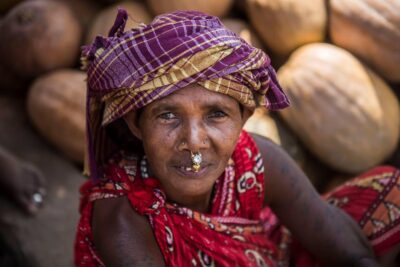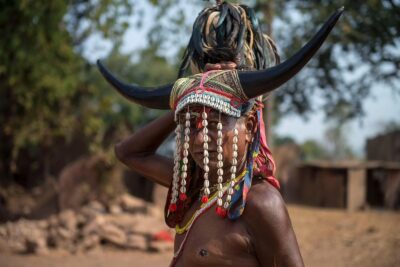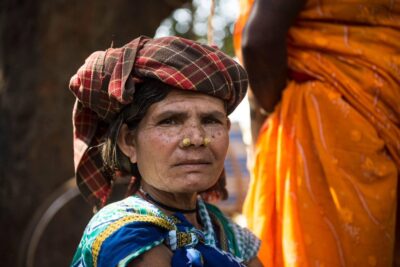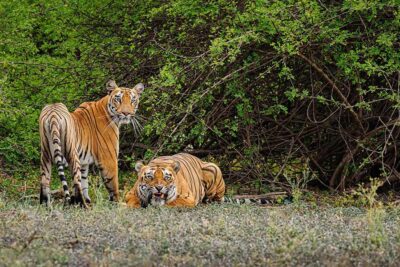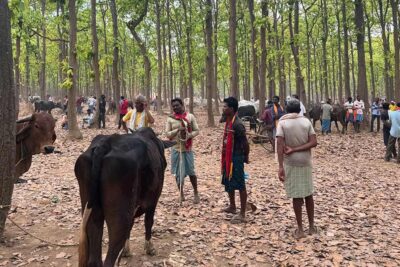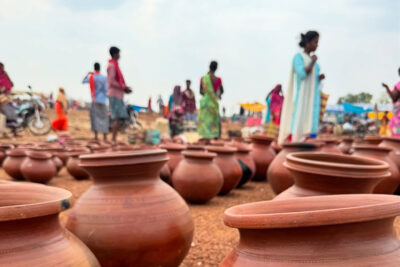Tribals, tigers and temples: a journey through Odisha & Chhattisgarh
15 days
This 15-day itinerary is designed for travellers seeking a deep immersion on the traditions and nature of Central India, discovering its tribal culture, environmental richness and temple heritage. This tour welcomes you to the tribal land of Orissa and Chattisgarh; the southwestern part of Orissa contains the largest concentration of tribal people in the sub-continent. There are more than 62 tribal communities in Orissa. They have retained their tradition alive in spite of the onslaught of the modern civilization. Over two weeks, you will explore regions that are among the least commercialized and most culturally intact in the country, offering a rare opportunity to witness ways of life, belief systems, and ecosystems that are increasingly difficult to access through conventional tourism.
The journey begins in Kolkata, the historical and intellectual capital of Eastern India. Known for its colonial architecture, vibrant street life, and literary traditions, the city provides a compelling starting point to understand the layered identity of modern India. After an introduction to its cultural and historical landmarks, the trip continues to Bhubaneswar, also called the “Temple City of India”, and the coastal towns of Konark and Puri, where classical temple architecture and living religious traditions intersect.
From there, the itinerary takes a more anthropological turn, entering the tribal heartlands of Odisha and Chhattisgarh. This segment includes direct encounters with indigenous communities such as the Kondh, Bonda, Gadaba, Desia, Muria, Maria, Baiga, and Gond tribes. These visits are organized around weekly markets, village walks, and artisan workshops, providing an in-depth view into tribal economies, social structures, ancestral customs, and sacred practices. Travelers will witness traditional weaving (such as double Ikat), lost-wax metal casting (Dhokra), symbolic tattoos, and youth dormitory systems (ghotuls), which are vital elements of these communities’ identities.
Beyond cultural immersion, the trip also emphasizes ecological diversity. In its final days, the itinerary shifts to Kanha National Park, one of India’s most renowned wildlife sanctuaries and a model for conservation under Project Tiger. Here, travelers will engage in guided safaris, nature walks, and educational interactions with local naturalists. The park offers opportunities to observe Bengal tigers, sloth bears, Indian bisons, leopards, and a variety of endemic flora and fauna, all within a protected and biodiverse ecosystem.
Accommodations throughout the journey are selected for their connection to local culture and environment, ranging from restored palaces and rural retreats to nature lodges inside forest reserves. The itinerary is paced to ensure a meaningful balance between activity and rest, observation and participation.
This program is ideal for culturally curious, socially conscious, and ecologically aware travelers. It avoids mass tourism routes and instead emphasizes responsible travel principles, respectful engagement with local communities, and a nuanced understanding of India’s complex cultural and natural heritage.
JOURNEY OVERVIEW AND PROGRAM DETAILS
1° DAY – ARRIVAL IN KOLKATA
Kolkata
Arrival at Kolkata International Airport and check in at the Hotel. Kolkata, is the capital of the state of West Bengal. Located on the east bank of the Hooghly River, it is the main commercial, cultural and educational center of East India, and its port is the oldest in the country and the only river port. Calcutta was the capital during British colonialism, for this reason preserves in many buildings the architectural style of that period, which contrasts sharply with the degradation of some urban areas and with the more recent and dynamic suburbs and with the inevitable air-conditioned shopping centers.
After a short rest 3h walk to discover the cultural heritage of the North of Kolkata, which includes the ancient noble palaces and mansions, the potters village in Kumartuli, the lively local shops and the narrow streets and alleys from which the city has evolved in a few centuries. Return to the hotel to have lunch and rest. In the afternoon, visit the Indian Museum, Victoria Memorial hall, St. John’s Church, and Kali Temple.
Overnight in Kolkata
DAY 2 – TRANFER TO BHUBANESWAR
Kolkata – Bhubaneswar
Early morning transfer to the airport and short flight to Bhubaneswar, the revered “Temple City of India”. Upon arrival, you’re welcomed with folded hands and warm smiles, then escorted through roads flanked by banyan trees and sacred silence, until reaching your hotel nestled in the historic heart of the city.
After a brief rest, the afternoon opens to an intimate exploration of Bhubaneswar’s spiritual spine — its ancient temples carved in sandstone and myth. You’ll begin with the delicate Mukteshwar Temple, an ode to tantric elegance, followed by the serene Parshurameswar and the majestic Lingaraj Temple, where priests still whisper mantras under towering spires. In the narrow alleys of the Old Town, daily life and divine rhythm move as one.Each step here is a return to the 8th century, where stone breathes stories and every carved arch is a hymn in itself. Sunset falls quietly, gilding the temple domes in amber light.
Overnight in Bhubaneswar (B)
DAY 3 – EXCURSION TO KONARK AND PURI
Bhubaneswar
After breakfast, the day opens with a journey toward the coast, where mythology and masonry merge in timeless dance. You’ll travel through fields of palm and rice to reach Konark, home to the legendary Sun Temple, a 13th-century symphony in stone. Here, the chariot of the sun god Surya stands still in motion, with 24 sculpted wheels and six stone horses, forever galloping toward the horizon. Every inch is a hymn carved in sandstone — erotic, divine, cosmic.
From the divine to the earthly, the road continues to quiet fishermen’s villages along the beach, where boats rest on the sand like sleeping animals, and nets dry under the sun like veils of memory. The faces here are worn by salt and wind, and every gesture tells a story. A paradise for the photographer, and a moment of connection with the India that rises before dawn and prays with the sea.
In the afternoon, arrive in Puri, sacred town of pilgrims and poets. Walk along the Grand Road, flanked by saffron flags and temple chants, and visit the Hindu cremation grounds, where flames return bodies to air and ash in the eternal rhythm of Samsara. As twilight sets in, return to Bhubaneswar, carrying with you the scent of incense, the roar of waves, and the silence of sculpted gods.
Overnight in Bhubaneswar (B)
DAY 4 – DRIVE TO DHENKANAL AND VISIT TO ARTISAN VILLAGES
Bhubaneswar – Dhenkanal (stay at the Royal Palace)
After breakfast, the journey curves into the heart of Odisha, leaving behind the temple skyline of Bhubaneswar and entering a quieter India, where craft and contemplation shape the day.
Our first stop is Nuapatna, a village that breathes through its looms. Here, families have preserved the rare art of Double Ikat weaving, a form of tie-and-dye where both warp and weft are pre-patterned, requiring patience, precision, and vision. As you step into the workshops, the clack of wooden looms and the soft murmur of artisans wrap the air like woven music. Every thread holds a story.
We continue toward Sadeibareni, a hamlet where the ancient art of Dhokra metal casting survives in earth and fire. Using the lost-wax technique, artisans create tribal figurines, deities, animals, each with its own rustic grace and spiritual weight. These objects seem born from the soil itself—unpolished, imperfect, and deeply alive.
By late afternoon, we reach Dhenkanal, where the day closes not in silence but in chant. At the Joranda Monastery, we witness the sunset prayers of the Mahima sadhus, barefoot ascetics wrapped in saffron, who worship the formless divine in a faith shaped by simplicity and austerity. As dusk falls, the fire ritual illuminates faces carved by discipline, and incense draws spirals in the air like whispered mantras.
Overnight in Dhenkanal (B, L, D).
DAY 5 – TRANFER TO BALIGUDA
Dhenkanal – Baliguda
After breakfast, we set out on a long yet unforgettable drive (approximately 6 hours) into the tribal heartlands of southern Odisha. As the landscape shifts from rolling plains to rugged hills and sal forests, we enter Kondh territory—a world where time has folded upon itself, and memory is etched on skin.
Our destination is Baliguda, gateway to the land of the Maliah Kondh, a subgroup of the ancient Kondh people. The women here bear striking facial tattoos, patterns reminiscent of tigers—once believed to offer protection and spiritual strength. These intricate markings, applied in early youth, tell of courage, belonging, and communion with nature.
The Kondhs were once known for human sacrifices in devotion to the Mother Earth goddess. Today, the rituals remain, transformed: a chicken or pig is symbolically offered, the blood nourishing the land, the gesture steeped in ancestral memory.
In the late afternoon, a short village walk will take us through clusters of thatched homes and stone altars, where we’ll see the sacrificial pillars still standing—silent, weathered relics of an old faith. There’s dignity in the people’s gaze, quiet rhythm in their daily gestures, and an air of spiritual resilience woven through the land.
Overnight in Baliguda (B, L, D).
DAY 6 – TRIBAL MARKET AND TRANFER TO JEYPORE
Baliguda – Chatikona – Jeypore
We depart at dawn, leaving behind the misty valleys of Baliguda for a day that will take us into the very heart of southern Odisha’s tribal culture. After an early breakfast, we begin our journey (approximately 6 hours in total) toward the forested hills of Chatikona, where a weekly tribal market brings the land to life with rhythm and color.
This is no ordinary bazaar—it is a living ritual, locally known as haat, held only on Wednesdays. Here, the elusive Dongaria Kondh, guardians of the sacred Niyamgiri Hills, descend barefoot from the highlands, wrapped in deep-blue shawls, silver jewelry gleaming against their dark skin, baskets balanced on their backs. They bring with them fruits, forest herbs, wild roots, and the quiet nobility of a life in deep symbiosis with the jungle. Alongside them, the Desia Kondh trade and barter, filling the air with the hum of dialects, the scent of leaves, and the warmth of ancestral memory.
Later, we continue our drive toward Jeypore, crossing hidden valleys and dense forest corridors. Along the way, we make meaningful stops in Mali and Kuvi Kondh villages. These tribes, known for their horticultural knowledge, cultivate terraced gardens clinging to the hillsides, rich with turmeric, ginger, and medicinal herbs. Their homes—crafted from clay and cow dung—echo a world that seems untouched by time.
By evening, we arrive in Jeypore, a modest town cradled between green hills, where the tribal world begins to gently merge with modern life.
Overnight at hotel in Jeypore (B, L, D).
DAY 7 – ONKUDELLI MARKET AND TRIBAL VILLAGES WALK
Jeypore – Onkudelli
After breakfast, we depart from Jeypore for a two-hour drive into the remote hills of southern Odisha, heading toward Onkudelli—a place that, every Thursday, transforms into a crossroads of primal humanity. The Onkudelli market, held exclusively on this day, is one of the most vibrant and authentic tribal gatherings in all of India. Here, language, barter, and memory converge under the scorching sun and red dust.
At the heart of this unique market are the Bonda women, considered among the most ancient and isolated indigenous communities in the country. With their cropped hair, cascading bead necklaces, thick silver neck rings, and brightly colored wrap-around cloths, they descend from the highlands of Malkangiri, walking for hours to trade forest produce, fermented drinks, herbs, seeds, and seasonal fruits. Their language, Remo, ripples through the market like an echo from another era. Alongside them, the Gadaba people—more outward-facing yet equally dignified—bring baskets filled with tubers, amulets, and rice wine, adding further vibrancy to this extraordinary gathering.
After this powerful encounter, we pause for a local lunch or a picnic at camp. In the afternoon, the pace slows as we explore the surrounding hills with a gentle walk through traditional settlements. We visit the villages of the Paroja and Ollar Gadaba—communities of farmers and artisans where red-earth trails lead to homes painted with natural pigments and roofed with palm leaves.
We also meet local potters, whose skilled hands mold the same clay that remembers both rain and fire, shaping vessels, lamps, and ritual objects passed down through generations.
By evening, we return to Jeypore, the impressions of the day still vivid on our skin and etched in memory.
Overnight at hotel in Jeypore (B, L, D).
DAY 8 – TRANSFER TO JAGDALPUR
Jeypore – Kotpad – Jagdalpur
After breakfast, we leave Jeypore and begin our westward journey toward the heart of Bastar (about 4 hours), following forest-lined roads and scattered tribal villages that echo with the rhythms of rural life.
Our first stop is Kotpad, a quiet village known for its ancient textile tradition. Here, local women dye handspun cotton with natural pigments made from roots and leaves, crafting deep earthy hues that seem to carry the voice of the land itself. We walk slowly through the weaving spaces, absorbing the quiet concentration of hands at work, the scent of herbal dyes, and the pulse of ancestral memory in every thread.
Continuing toward Jagdalpur, we stop at the Anthropological Museum, a compact but powerful space housing artifacts, ornaments, and ritual objects from the tribal groups of Bastar. Each display tells a story of coexistence with the forest, of myth, survival, and ritual intricacy.
In the afternoon, we arrive at Lohandiguda, where the weekly Friday market gathers the Maria Gond tribes. The air is filled with the scent of spices, the vibrant colours of produce, and the clang of handmade tools. Away from the main stalls, a crowd gathers around a dirt ring: it’s time for cockfighting, a long-standing tribal tradition. Bets are placed, drums roll, and roosters clash under watchful tribal eyes — a fierce echo of Bastar’s warrior roots.
As the sun begins to dip, we make a final stop at the majestic Chitrakoot Falls. Known as the “Niagara of Central India”, the falls plunge in sheets of white mist and thunder. We pause briefly for a cup of chai, standing quietly as water, rock, and light blur together in a scene that feels sacred.
Overnight stay in Jagdalpur (B, L, D).
DAY 9 – TRANSFER TO KANKER
Jagdalpur – Kanker
After breakfast, we leave behind the red earth of Jagdalpur and head northward, where the forest breathes deeper and the hills roll gently. The journey to Kanker (about 4 hours) is not a mere transfer, but a path of discovery.
Along the way, we stop in Kondagaon, a village renowned for its tribal craftsmanship. Here, the art is born from fire and patience — bell metal sculptures, delicate wrought iron forms, and terracotta figures emerge from the hands of artisans who carry centuries of ancestral skill. Their work speaks without words, echoing nature, ritual, and memory.
In the afternoon, we continue to the Deer Horn Muria villages, where community and forest live as one. The ghotul — youth dormitories — still stand as symbols of collective learning and quiet rebellion. The Muria way is slow and circular, like their dances, like their time.
As the sun dips behind the sal trees, we arrive at Kanker Palace, once a royal residence, now a home of stillness and grace. The air here carries old songs.
Overnight in Kanker (B, L, D)
DAY 10 – TRANSFER TO BHORAMDEO
Kanker – Bhoramdeo
After breakfast, we leave the shaded courtyards of Kanker Palace and set out toward the sacred heart of Chhattisgarh. The road to Bhoramdeo (about 6 hours) winds through dense forests and quiet villages, where life unfolds without hurry and every tree feels inhabited by spirit.
Along the way, we stop in Gond villages, where the walls of homes are adorned with vibrant, symbolic murals — visions of animals, stars, ancestors, and forest deities. The Gond believe that everything living carries a story, and that story can be drawn, sung, or simply remembered in silence.
The journey is long but deeply meditative. The farther we go, the more the world seems to soften.
By late afternoon, we reach Bhoramdeo, nestled among sal trees and red earth. Here stands the Jungle Retreat, a place of stillness where the forest speaks in bird calls and rustling leaves. The evening is yours to settle, to breathe, and to listen.
Overnight at Jungle Retreat (B, L, D).
DAY 11 – BAIGA AND GOND COMMUNITIES
Bhoramdeo
Today unfolds slowly, as it should in places where time has roots.
After breakfast, we venture deep into the ancestral lands of the Baiga and Gond communities — tribes whose lives remain closely woven with the rhythm of the forest. We walk along red-earth paths shaded by tall sal trees, stopping in villages where stories are passed not through books, but through dances, tattoos, chants, and murals painted on the walls of homes.
With a picnic lunch carried beneath the canopy, we break bread in the open, embraced by silence and soft breeze. Here, even a shared fruit or a gourd of water feels sacred.
In the afternoon, we return to visit the Bhoramdeo temple, a jewel of stone and time hidden among the trees. Its sculpted walls speak of divine eros, meditation, and the fluid boundary between the sacred and the sensual. You’ll walk among its columns slowly, like entering a dream carved in basalt.
Evening at leisure at the Jungle Retreat, where the forest returns as music in the night.
Overnight at Jungle Retreat (B, L, D).
DAY 12 – TRANSFER TO KANHA NATIONAL PARK
Bhoramdeo – Parco Nazionale di Kanha
After breakfast, departure from Bhoramdeo toward Kanha National Park (approx. 4 hours and 30 minutes). As you cross the border from Chhattisgarh into Madhya Pradesh, the landscape begins to unfold in slow, wide waves—forests thick with sal trees, sun-dappled meadows, rivers weaving like silver threads.
Kanha is India’s largest wildlife sanctuary, nestled in the Mandla district and known as one of the most successful tiger conservation areas under Project Tiger. It was once the royal hunting ground of the Viceroy; today it is a sacred refuge, where Bengal tigers, Indian bisons (gaur), and the rare four-horned antelopes roam freely. This is the very land that inspired The Jungle Book, where Rudyard Kipling gave literary breath to legends whispered by the wind through the trees.
In the afternoon, embark on your first thrilling safari in a 4×4 Gypsy jeep (3:00 pm – 6:00 pm). This golden-hour excursion offers the chance to spot the Royal Bengal Tiger, Gaur, Sambhar, and other wildlife in their natural habitat—bathed in the warm light that makes for striking photography.
Return to the lodge in the early evening for a quiet dinner surrounded by the sounds of the forest, and a restful night—ready to rise with the jungle on the following day.
Overnight in Kanha. (B, L, D)
DAY 13 – THE TIGER’S REALM
Kanha National Park
At dawn, as the mist rises from the forest floor, begin your early morning safari (5:30 am – 11:00 am) into the heart of Kanha National Park. Mornings are the most active hours for the jungle’s inhabitants and offer the best chances to encounter the elusive tiger. You may also spot sloth bears, Indian bison, or the swift silhouette of a leopard. A packed breakfast will be served at a scenic spot within the park, as the jungle slowly awakens around you.
After lunch and a brief rest, the afternoon opens to a softer rhythm of discovery. Accompanied by an expert naturalist, you will set out on a gentle nature walk in the buffer zone, an experience designed to awaken your senses to the forest’s subtler voices—birdsong, the flicker of wings, medicinal plants hidden in plain sight. This walk unveils the secret choreography of the undergrowth, where not just tigers but grasses, insects, and vines have stories to tell.
Later, a cultural excursion leads you to a nearby tribal village, where the heartbeat of local life beats in craft, color, and community. Here, among mud houses and handwoven textiles, you’ll meet artisans and elders, children and farmers—each offering a glimpse into traditions shaped by generations of coexistence with the forest.
As the sun sets behind the sal trees, return to the lodge for a quiet evening of rest, the sounds of the jungle folding gently into night.
Overnight in Kanha. (B, L, D)
DAY 14 – TRANFER TO KOLKATA
Kanha – Jabalpur – Kolkata
After breakfast, departure from Kanha toward Jabalpur (approximately 4 hours), crossing through the green corridors of central India—sal forests, red earth, and early morning rituals glimpsed from the roadside.
Upon reaching Jabalpur airport, flight to Kolkata. By afternoon, you arrive once more in the city where your journey began—Kolkata, vibrant and timeless, wrapped in the scent of cardamom and books, of tram bells and burning incense.
Check-in at your hotel and rest, or choose to spend your final hours wandering the ghats of the Hooghly, sipping chai in quiet cafés, or picking up last-minute memories in the city’s antique shops and markets.
Overnight in Kolkata (B).
DAY 15 – DEPARTURE FROM KOLKATA
Kolkata
After breakfast, transfer to the international airport for your return flight.
The journey ends, but its echo remains—in the hush of the forest, the rhythm of the chants, the colors of the saris, and the warmth of every encounter.
ACTIVITIES
- Discover Kolkata’s colonial architecture, artisanal quarters, and cultural landmarks
- Explore the temples of Bhubaneswar, known as the “Temple City of India”
- Visit the UNESCO-listed Sun Temple of Konark and the pilgrimage town of Puri
- Meet traditional weavers and learn the Double Ikat technique in Nuapatna
- Experience Dhokra metal casting in the artisan village of Sadeibareni
- Witness the sacred rituals of Mahima monks at Joranda Monastery
- Encounter the tattooed Kondh women and explore tribal spirituality in Baliguda
- Visit the weekly tribal markets of Chatikona and Onkudelli, meeting Bonda, Dongaria and Gadaba communities
- Walk through remote villages and observe traditional pottery and mural art
- Explore Kotpad’s natural-dye textile workshops and tribal museum in Bastar
- Attend the Friday market of the Maria Gond tribes and visit Chitrakoot Falls
- Discover the ghotul system and tribal crafts in Muria and Gond villages
- Immerse yourself in Baiga and Gond forest communities with a picnic under the sal trees
- Visit Bhoramdeo Temple, an architectural gem of sacred and sensual symbolism
- Enjoy wildlife safaris and a nature walk in Kanha National Park, home of the Bengal tiger
SOCIAL AND ENVIRONMENTAL IMPACT
This journey has been carefully designed to generate tangible benefits for local communities, indigenous groups, and the surrounding ecosystems, following the core principles of responsible tourism. Whenever possible, accommodations and services are sourced from local providers, including heritage properties, tribal-run homestays, and eco-lodges committed to social and environmental sustainability.
A key feature of the itinerary is the direct engagement with tribal communities across Odisha and Chhattisgarh. These include the Kondh, Gadaba, Bonda, Dongaria, Maria Gond, Muria, Baiga, and Gond peoples—many of whom live in remote forested areas with limited access to economic opportunities. Through respectful and pre-arranged visits to weekly tribal markets and artisan villages, the trip provides them with income support, helps preserve their cultural heritage, and encourages the transmission of traditional skills such as weaving, metal casting, pottery, and mural painting.
Artisan hubs like Nuapatna, Sadeibareni, Kotpad, and Kondagaon are not only cultural stops, but also represent grassroots economic networks. Travelers support these communities directly through the purchase of handcrafted items, and indirectly by validating the importance of their craft traditions in a globalized economy.
The program includes overnight stays or guided visits in tribal villages and remote rural areas where tourism is rare. This ensures that tourism revenue flows to underrepresented regions, contributing to decentralized development while fostering cultural pride and mutual understanding. Participation is designed to be non-intrusive and follows ethical guidelines to protect community dignity and consent.
From an environmental perspective, the journey emphasizes low-impact mobility, use of local resources, and education around biodiversity. The final part of the itinerary includes two full days in Kanha National Park, one of India’s most successful tiger conservation zones under Project Tiger. Here, guests are introduced to conservation strategies, biodiversity protection, and human–wildlife coexistence, with the guidance of certified naturalists. The stay in Kanha supports the surrounding buffer-zone communities that rely on eco-tourism for sustainable livelihoods.
By choosing this itinerary, travellers contribute to the long-term preservation of tribal cultures, local crafts, and forest ecosystems—while promoting dignity-based, fair, and environmentally conscious travel.
TIPS BEFORE DEPARTURE
A conscious approach to travel requires a considerable capacity and willingness to adapt and adjust to the local environment and culture. If you wish to travel with us, we request you to be open enough to experience local traditions, tribal lifestyles and spiritual practices without bias or pre-conceived ideas based on our Western way of thinking. With curiosity and patience, you will gain access to the deep cultural heritage and authenticity of the places and communities you are going to visit.
This itinerary includes visits to remote rural and tribal areas with limited infrastructure. Accommodations are chosen for their cultural value and environmental sensitivity, and may not always meet Western comfort standards. Electricity cuts, basic sanitation, and long drives on bumpy roads are part of the journey.
Weather can vary: expect heat, humidity, and possible rain, especially in forested areas. Pack layered clothing, a light rain jacket, good walking shoes, insect repellent, and essential medication. A flashlight, water bottle, and small backpack are highly recommended.
Temples and tribal shrines require respectful clothing. Avoid shorts, sleeveless tops, and tight garments. Always ask permission before photographing people, especially in tribal villages.
This itinerary is not suitable for travelers seeking comfort or rapid sightseeing. A basic physical condition, a respectful attitude, and openness to cultural difference are essential for fully enjoying this unique experience.
HOTELS
Accommodation includes a selection of urban hotels, heritage palaces, forest retreats, and eco-lodges. All properties are chosen for their cultural relevance, local character, and sensitivity to environmental and community impact. Comfort levels vary depending on location, especially in rural and tribal areas.
TRASPORT
All transfers are arranged with private vehicles suited to local road conditions. Short internal flights are included. In remote or off-road areas, transportation is provided with reliable off-road vehicles driven by local experts.
WHEN TO GO
The best time to travel is from October to March, when temperatures are mild, the climate is dry, and all tribal markets are fully active. This period is ideal for visiting rural villages, attending weekly tribal gatherings such as the Chatikona market (Wednesdays) and Onkudelli market (Thursdays), and accessing forested regions without disruption. Wildlife safaris in Kanha National Park are also at their best from November to February, when sightings are frequent and the climate is comfortable.
From April to June, temperatures rise significantly, especially in the plains, but this can be a good period for animal spotting, as wildlife tends to gather near water sources. However, it may not be ideal for long road journeys or visits to tribal areas due to the heat.
The monsoon season, from July to mid-October, brings heavy rains that often make rural roads difficult or inaccessible. Most tribal markets become irregular or harder to reach, and Kanha National Park is officially closed from mid-July to mid-October.


